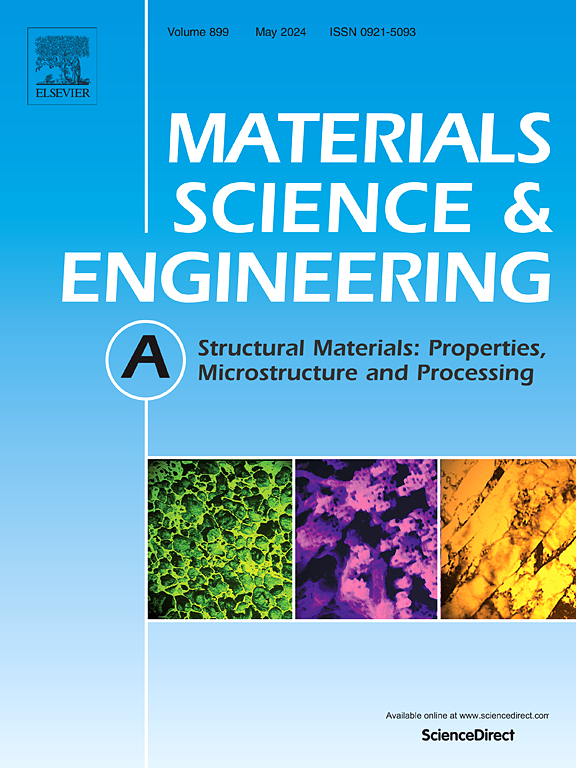热处理AlSi7Cu3Mg铸造合金的原位研究:凝固速率对循环疲劳行为的影响
IF 6.1
2区 材料科学
Q1 MATERIALS SCIENCE, MULTIDISCIPLINARY
引用次数: 0
摘要
研究了循环加载条件下凝固速率对热处理AlSi7Cu3Mg铸造合金裂纹萌生和扩展的影响。在Bridgman炉中采用三种不同的冷却速度,以提高合金的细到粗组织的可控性,并采用相同的凝固后热处理参数。通过光学显微镜、扫描电子显微镜和能量色散x射线分析进行了显微组织表征,并对Si颗粒进行了定量分析,以加深凝固速率对其几何特征的影响。通过扫描电镜原位疲劳试验和电子背散射衍射分析,研究了合金的二维疲劳行为与微观组织特征粗糙度的关系。在裂纹尖端前进行聚焦离子束切片和三维断层扫描,发现随着显微组织粗糙度的降低,微裂纹更靠近金属间颗粒。EBSD分析也支持了不同凝固速率对穿晶/沿晶扩展路径影响的相关结果。为了更好地了解合金的力学性能,还进行了拉伸和显微硬度测试。结果表明,凝固速率和热处理对控制疲劳裂纹的萌生和扩展路径具有协同作用。具体而言,较高的凝固速率导致微观组织更细,Si颗粒更小、更圆,α-Al基体硬度提高,共晶区疲劳裂纹萌生和扩展集中。这与较低的凝固速率形成鲜明对比,在较软的α-Al基体或较大的Si和金属间颗粒附近,裂纹更容易产生和扩展。本文章由计算机程序翻译,如有差异,请以英文原文为准。
In-situ investigation of a heat-treated AlSi7Cu3Mg cast alloy: influence of solidification rate on the cyclic fatigue behaviour
The study investigates the influence of the solidification rate on both crack initiation and propagation on a heat-treated AlSi7Cu3Mg cast alloy under cyclic loading conditions. Three different cooling speeds were applied to the alloy in a Bridgman furnace to enhance controlled fine to coarse microstructures, and the same post-solidification heat treatment parameters were adopted. Optical microscopy, scanning electron microscopy and energy dispersive x-ray analyses were performed for the microstructural characterisation, which also concerned quantitative analyses on Si particles to deepen the effect of the solidification rates on their geometrical features. In-situ fatigue tests in a scanning electron microscope and electron backscattered diffraction analyses were carried out to study the two-dimensional fatigue behaviour of the alloy depending on the coarseness of the microstructural features. Focused ion beam slices and three-dimensional tomography were performed ahead of the crack tips, revealing micro-cracks closer to the intermetallic particles with the decreasing of the microstructural coarseness. EBSD analyses also supported results correlating the effect of different solidification rates on the transgranular/intergranular propagation paths. In contrast, tensile and microhardness tests were also conducted to better understand the mechanical properties of the alloy. The results showed that the solidification rate and the heat treatment have a synergic effect in controlling the fatigue crack initiation and the subsequent propagation path. Specifically, higher solidification rates lead to a finer microstructure with smaller, rounder Si particles, increased hardness of the α-Al matrix, and concentrated fatigue crack initiation and propagation in eutectic areas. This contrasts with lower solidification rates, where cracks are more likely to initiate and propagate in the softer α-Al matrix or near larger Si and intermetallic particles.
求助全文
通过发布文献求助,成功后即可免费获取论文全文。
去求助
来源期刊

Materials Science and Engineering: A
工程技术-材料科学:综合
CiteScore
11.50
自引率
15.60%
发文量
1811
审稿时长
31 days
期刊介绍:
Materials Science and Engineering A provides an international medium for the publication of theoretical and experimental studies related to the load-bearing capacity of materials as influenced by their basic properties, processing history, microstructure and operating environment. Appropriate submissions to Materials Science and Engineering A should include scientific and/or engineering factors which affect the microstructure - strength relationships of materials and report the changes to mechanical behavior.
 求助内容:
求助内容: 应助结果提醒方式:
应助结果提醒方式:


